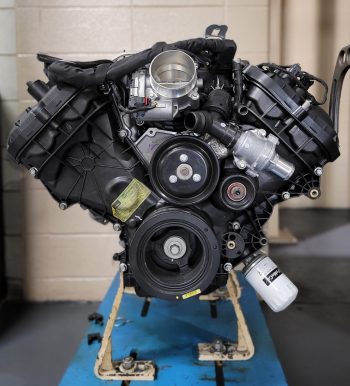An academic-industry collaboration led by Professor Mohini Sain (MIE) has produced a new sustainably-sourced, production-ready engine component for high-performance vehicles.
The new part reduces emissions by both, displacing fossil fuel-derived plastics with renewable alternatives that can be recycled, and by decreasing vehicle weight, leading to improved fuel efficiency.
The Carbon Fibre-Composite 5.0L Engine Timing Cover was created over the course of five years through an NSERC-supported partnership and ORF-RE project between Sain’s lab group and Ford Canada’s Powertrain Research and Development Centre (PERDC), led by Dr. Jimi Tjong, the technical lead at its Essex Engine Plant in Windsor, Ont., which is equipped with more than 20 design and process engineers.
“My goal is to not only do research; I want to be involved in the process from research to commercialization,” says Sain. “Our research group starts with the fundamental research and then we translate it into practice, going from concept to production-ready products.”
“We constantly consult with our industry experts to bring synergy in our design engineering to develop optimal cost/performance balance. Pricing is a key factor in driving our innovation.”
As the Director of U of T Engineering’s Centre for Biocomposites and Biomaterials Processing, Sain is a leading researcher in advanced low-carbon materials and sustainable bio-manufacturing.
He has a track record of working with industry partners to create low-carbon, carbon-neutral, or carbon-negative products and advanced manufacturing processes that can help reduce greenhouse gas emissions.
Sain previously commercialized bio-composites designed to be used in the interior of Ford vehicles. But focusing on the structure and the powertrain elements have a greater potential impact because these parts are among the heaviest components of a vehicle.
Engine timing covers, which are typically made of metals like aluminum or fossil-fuel-derived plastic, protect the timing components inside a vehicle’s engine.

By contrast, the material that Sain and his team have created is a novel multi-functional composite that combines engineered carbon material from sustainable sources with recycled carbon fibre that has a tunable carbon structure and interfacial chemistry, and engineered polyamides.
Simply making a “greener” engine component is not enough to bring about a change in the industry, says Sain. The new material must perform as well or better than what it is replacing.
“One of the challenges for us was competing with metal in terms of strain, structure, crashworthiness, esthetics and long-term stability. And metal is also very heavy,” he says.
“We also wanted to build a circular carbon economy so that the material we make from sustainable sources can be recycled at the end of its life.”
Sain and his team spent years collaborating with Tjong and the researchers at Ford to perfect the mechanical characterization and composite rheology of the new component. They also collaborated on developing the processes by which it is made.
“Since it’s a new material and new design, we were involved with designing the mould and the manufacturing process,” Sain says. “At each stage of development, we had to work closely with the Ford team on specifications to get the product to the marketplace.”
The final design not only introduces a new sustainable material into the automotive industry, but it is also seven pounds lighter than previous models, while providing a sleek appearance and functionality critical for reducing emissions and increasing the performance advantage for racing vehicles.
Ford’s Carbon Fibre-Composite 5.0L Engine Timing Cover featured at the 2021 SEMA New Product Showcase in Las Vegas this past November and was recognized by its Global Media Awards, which are chosen by the automotive industry’s top publications.
Sain hopes that the new timing cover can serve as a proof-of-concept that will enable further expansion of low carbon composites in electric vehicles.
“The larger benefit of this new material and manufacturing process is its application in lightweight structural battery pack and fuel cell packs, with added functionality such as electromagnetic interference shielding,” he says.
“If we want to reach carbon neutrality, we have to find ways to have more energy-efficient processes that use fewer materials and fewer resources with enhanced functionality. There are tremendous opportunities for transformative change.”



